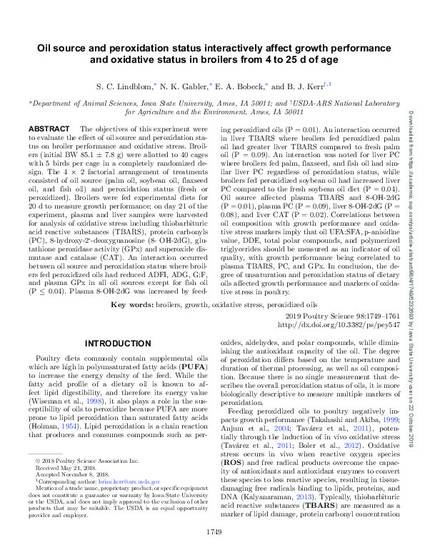
The objectives of this experiment were to evaluate the effect of oil source and peroxidation status on broiler performance and oxidative stress. Broilers (initial BW 85.1 ± 7.8 g) were allotted to 40 cages with 5 birds per cage in a completely randomized design. The 4 × 2 factorial arrangement of treatments consisted of oil source (palm oil, soybean oil, flaxseed oil, and fish oil) and peroxidation status (fresh or peroxidized). Broilers were fed experimental diets for 20 d to measure growth performance; on day 21 of the experiment, plasma and liver samples were harvested for analysis of oxidative stress including thiobarbituric acid reactive substances (TBARS), protein carbonyls (PC), 8-hydroxy-2'-deoxyguanosine (8- OH-2dG), glutathione peroxidase activity (GPx) and superoxide dismutase and catalase (CAT). An interaction occurred between oil source and peroxidation status where broilers fed peroxidized oils had reduced ADFI, ADG, G:F, and plasma GPx in all oil sources except for fish oil (P ≤ 0.04). Plasma 8-OH-2dG was increased by feeding peroxidized oils (P = 0.01). An interaction occurred in liver TBARS where broilers fed peroxidized palm oil had greater liver TBARS compared to fresh palm oil (P = 0.09). An interaction was noted for liver PC where broilers fed palm, flaxseed, and fish oil had similar liver PC regardless of peroxidation status, while broilers fed peroxidized soybean oil had increased liver PC compared to the fresh soybean oil diet (P = 0.04). Oil source affected plasma TBARS and 8-OH-2dG (P = 0.01), plasma PC (P = 0.09), liver 8-OH-2dG (P = 0.08), and liver CAT (P = 0.02). Correlations between oil composition with growth performance and oxidative stress markers imply that oil UFA:SFA, p-anisidine value, DDE, total polar compounds, and polymerized triglycerides should be measured as an indicator of oil quality, with growth performance being correlated to plasma TBARS, PC, and GPx. In conclusion, the degree of unsaturation and peroxidation status of dietary oils affected growth performance and markers of oxidative stress in poultry.
Available at: http://works.bepress.com/elizabeth-bobeck/18/

This article is published as Lindblom, S. C., N. K. Gabler, E. A. Bobeck, and B. J. Kerr. "Oil source and peroxidation status interactively affect growth performance and oxidative status in broilers from 4 to 25 d of age." Poultry science 98, no. 4 (2018): 1749-1761. doi: 10.3382/ps/pey547.